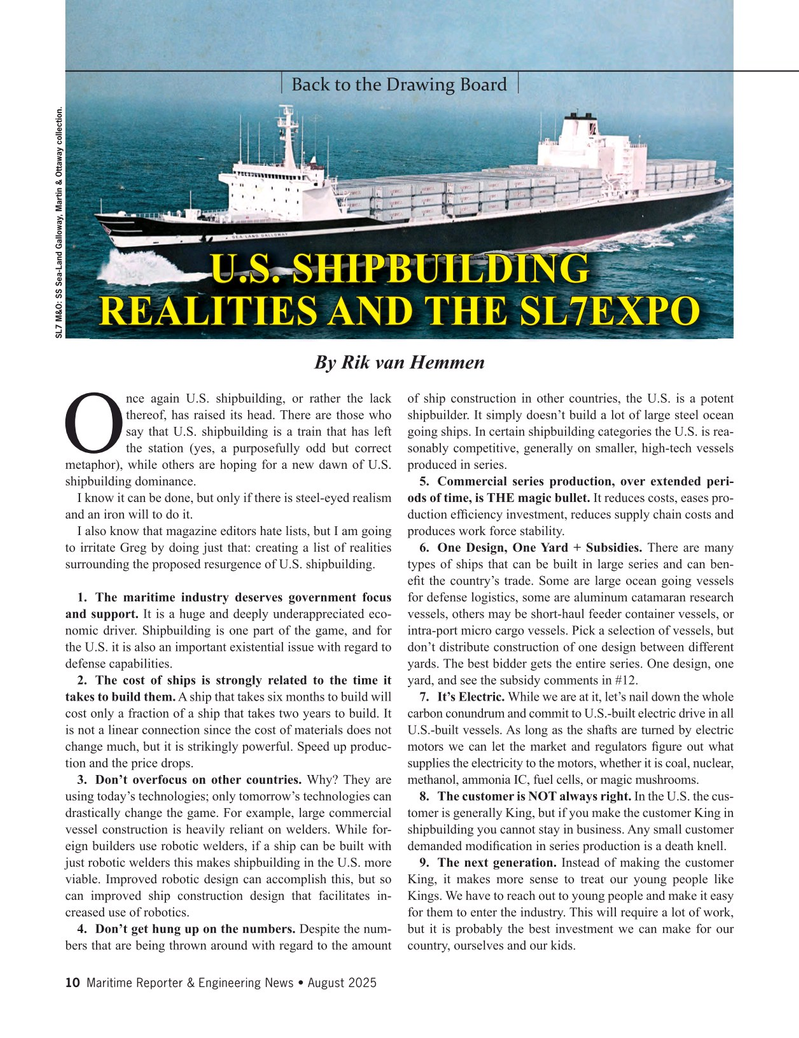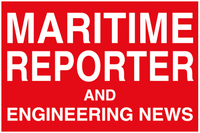
Page 10: of Maritime Reporter Magazine (August 2025)
Read this page in Pdf, Flash or Html5 edition of August 2025 Maritime Reporter Magazine
Back to the Drawing Board
U.S. SHIPBUILDING U.S. SHIPBUILDING
REALITIES AND THE SL7EXPOREALITIES AND THE SL7EXPO
SL7 M&O: SS Sea-Land Galloway, Martin & Ottaway collection.
By Rik van Hemmen nce again U.S. shipbuilding, or rather the lack of ship construction in other countries, the U.S. is a potent thereof, has raised its head. There are those who shipbuilder. It simply doesn’t build a lot of large steel ocean say that U.S. shipbuilding is a train that has left going ships. In certain shipbuilding categories the U.S. is rea-
O the station (yes, a purposefully odd but correct sonably competitive, generally on smaller, high-tech vessels metaphor), while others are hoping for a new dawn of U.S. produced in series.
shipbuilding dominance. 5. Commercial series production, over extended peri-
I know it can be done, but only if there is steel-eyed realism ods of time, is THE magic bullet. It reduces costs, eases pro- and an iron will to do it. duction ef? ciency investment, reduces supply chain costs and
I also know that magazine editors hate lists, but I am going produces work force stability. to irritate Greg by doing just that: creating a list of realities 6. One Design, One Yard + Subsidies. There are many surrounding the proposed resurgence of U.S. shipbuilding. types of ships that can be built in large series and can ben- e? t the country’s trade. Some are large ocean going vessels 1. The maritime industry deserves government focus for defense logistics, some are aluminum catamaran research and support. It is a huge and deeply underappreciated eco- vessels, others may be short-haul feeder container vessels, or nomic driver. Shipbuilding is one part of the game, and for intra-port micro cargo vessels. Pick a selection of vessels, but the U.S. it is also an important existential issue with regard to don’t distribute construction of one design between different defense capabilities. yards. The best bidder gets the entire series. One design, one 2. The cost of ships is strongly related to the time it yard, and see the subsidy comments in #12.
takes to build them. A ship that takes six months to build will 7. It’s Electric. While we are at it, let’s nail down the whole cost only a fraction of a ship that takes two years to build. It carbon conundrum and commit to U.S.-built electric drive in all is not a linear connection since the cost of materials does not U.S.-built vessels. As long as the shafts are turned by electric change much, but it is strikingly powerful. Speed up produc- motors we can let the market and regulators ? gure out what tion and the price drops. supplies the electricity to the motors, whether it is coal, nuclear, 3. Don’t overfocus on other countries. Why? They are methanol, ammonia IC, fuel cells, or magic mushrooms.
using today’s technologies; only tomorrow’s technologies can 8. The customer is NOT always right. In the U.S. the cus- drastically change the game. For example, large commercial tomer is generally King, but if you make the customer King in vessel construction is heavily reliant on welders. While for- shipbuilding you cannot stay in business. Any small customer eign builders use robotic welders, if a ship can be built with demanded modi? cation in series production is a death knell.
just robotic welders this makes shipbuilding in the U.S. more 9. The next generation. Instead of making the customer viable. Improved robotic design can accomplish this, but so King, it makes more sense to treat our young people like can improved ship construction design that facilitates in- Kings. We have to reach out to young people and make it easy creased use of robotics. for them to enter the industry. This will require a lot of work, 4. Don’t get hung up on the numbers. Despite the num- but it is probably the best investment we can make for our bers that are being thrown around with regard to the amount country, ourselves and our kids. 10 Maritime Reporter & Engineering News • August 2025
MR #8 (1-17).indd 10 MR #8 (1-17).indd 10 8/4/2025 8:31:26 AM8/4/2025 8:31:26 AM

 9
9

 11
11
